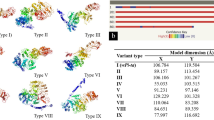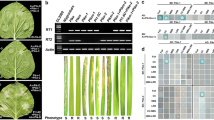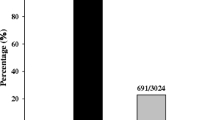Abstract
Rice blast is one of the important diseases of rice which can be effectively managed by the deployment of resistance genes. Pi-ta is one of the major blast resistant genes effective against pathogen populations in different parts of India. We analysed allelic variants of Pi-ta from 48 rice lines selected after phenotyping of 529 rice landraces across three eco-geographical blast hot spot regions. Besides, Pi-ta orthologue sequences of 220 rice accessions belonging to wild and cultivated species of rice were also included in the study for a better evo–devo perspective of the diversity present in the gene and the selection pressures acting on this locus. We obtained high nucleotide variations (SNPs and insertion–deletions) in the intronic region. We also identified 64 haplotypes based on nucleotide polymorphism in these alleles. Pi-ta orthologues of Indian landraces were scattered in eight major haplotypes indicating its heterogenous nature. We identified a total of 47 different Pi-ta protein variants on the basis of deduced amino acid residues amongst the orthologues. Five unique and novel Pi-ta variants were identified for the first time in rice landraces exhibiting different reaction types against the Magnaporthe oryzae population. A high value of Pinon/syn was observed only in the leucine-rich domain of the alleles cloned from Indian landraces, indicating strong selective forces acting on this region. The detailed molecular analysis of the Pi-ta orthologues provides insights to a high degree of inter- and intraspecific relationships amongst the Oryza species. We identified rice landraces possessing the effective alleles of this resistance gene which can be used in future blast resistance breeding programmes.






Similar content being viewed by others
References
Ashikawa I, Wu J, Matsumoto T, Ishikawa R (2009) Haplotype diversity and molecular evolution of the rice Pikm locus for blast resistance. J Gen Plant Pathol 1–6
Bakker EG, Toomajian C, Kreitman C, Bergelson J (2006) A genome-wide survey of R- gene polymorphisms in Arabidopsis. Plant Cell 18:1803–1818
Bonmann JM, Dedios TV, Khin MM (1986) Physiologic specialization 718 of Pyricularia oryzae in Philippines. Plant Dis 70:767–769
Bryan GT, Wu KS, Farrall L, Jia Y, Hershey HP, McAdams SA, Faulk KN, Donaldson GK, Tarchini R, Valent B (2000) tA single amino acid difference distinguishes resistant and susceptible alleles of the rice blast resistance gene Pi-ta. Plant Cell 12(11):2033–2046
Dai Y, Jia Y, Correll J, Wang X, Wang Y (2010) Diversification and evolution of the avirulence gene AVR-Pita1 in fields isolate of Magnaporthe oryzae. Fungal Genet Biol 47:973–980
Das A, Soubam D, Singh PK, Thakur S, Singh NK, Sharma TR (2012) A novel blast resistance gene, Pi54rh cloned from wild species of rice, Oryza rhizomatis confers broad spectrum resistance to Magnaporthe oryzae. Funct Integr Genomics 12:215–228
Ewing B, Green P (1985) Base calling sequencer traces using Phred II. Error probabilities. Genome Res 8(3):175–185
Excoffier L, Laval G, Schneider S (2005) Arlequin ver 30: an integrated software package for population genetics data analysis. Evol Bioinform 1:47–50
Fu YX, Li WH (1993) Statistical tests of neutrality of mutations. Genetics 133:693–709
Gupta PK, Rustogi S (2004) Molecular markers from the transcribed/expressed region of the genome in higher plants. Funct Integr Genomics 4:139–162
Hwang CF, Bhakta AV, Truesdell GM, Pudlo WM, Williamson VM (2000) Evidence for a role of the N terminus and leucine-rich repeat region of the Mi gene product in regulation of localized cell death. Plant Cell 12:1319–1329
Huang E, Hwang S, Chiang Y, lin T (2008) Molecular evolution of the Pi-ta gene resistant to rice blast in wild rice (Oryza rufipogon). Genetics 179:1527–1538
Hulbert SH, Webb CA, Smith SM, Sun Q (2001) Resistance gene complexes: evolution and utilization. Annu Rev Phytopathol 39:285–312
IRGSP (International Rice Genome Sequencing Project) (2005) The map-based sequence of the rice genome. Nature 436:793–800
Jia Y, McAdams SA, Bryan GT, Hershey HP, Valent B (2000) Direct interaction of resistance gene and avirulence gene products confers rice blast resistance. EMBO J 19:4004–4014
Jia Y, Martin R (2008) Identification of a new locus Ptr(t) required for rice blast resistance gene Pi-ta-mediated resistance. Mol Plant Microbe Interact 21:396–403
Lee S, Costanzo S, Jia Y, Olsen KM, Caicedo AL (2009) Evolutionary dynamics of the genomic region around the blast resistance gene Pi-ta in AA genome Oryza species. Genetics 183:1315–1325
Lee S, Jia Y, Jia M, Gealy DR, Olsen KM (2011) Molecular evolution of the rice blast resistance gene Pi-ta in invasive weedy rice in the USA. PLoS ONE 6(10):e26260. doi:10.1371/journal.pone.0026260
Meyers BC, Kozik A, Griego A, Kuang H, Michelmore RW (2003) Genome-wide analysis of NBS-LRR-encoding genes in Arabidopsis. Plant Cell 15:809–834
Moldenhauer KAK, Lee FN, Gibbons JW, Bernhardt JL, Norman RJ, Slaton NA, Wilson CEK, Bulloch JM (2007) Registration of ‘Ahrent’ rice. Crop Sc 47:446–447
Murray MG, Thompson WF (1980) Rapid isolation of high molecular weight plant DNA. Nucleic Acids Res 8:4321–4325
Nei M (1987) Molecular evolutionary genetics. Columbia University Press, New York
Orgil U, Arakit H, Tangchaiburana S, Herkey R, Xiao S (2007) Intraspecific genetic variations fitness cost and benefit of rpw8 a disease resistance locus in Arabidopsis thaliana. Genetics 176:2317–2333
Prim RC (1957) Shortest connection networks and some generalizations. Bell System Technical J 36:1389–1401
Rakshit S, Rakshit A, Matsumura H, Takahashi Y, Hasegawa Y, Ito A, Ishii T, Miyashita NT, Terauchi R (2007) Large scale DNA polymorphism study of Oryza sativa and Oryza rufipogon reveals the origin and divergence of Asian rice. Theor Appl Genet 114:731–743
Rose IE, Bittner-eddy PD, Langley CH, Holub EB, Michelmore RW, Beyone JL (2004) The maintenance of extreme amino acid diversity at the disease resistance gene rpp13 in Arabidopsis thaliana. Genetics 166:1517–1527
Rozas J, Sánchez-DelBarrio JC, Messeguer X, Rozas R (2003) DnaSP, DNA polymorphism analyses by the coalescent and other methods. Bioinformatics 19:2496–2497
Rybka K, Miyamoto M, Ando I, Saito A, Kawasaki S (1997) High resolution mapping of indica-derived rice blast resistance genes Pi-ta 2 and pi-ta and a consideration of their origin. Mol Plant Microbe-Interact 10:517–524
Schmid M, Davison TS, Henz SR, Pape UJ, Demar M, Vingron M, Scholkopf B, Weigel D, Lohmann JU (2005) A gene expression map of Arabidopsis thaliana development. Nat Genet 37(5):501–506
Sharma TR, Rai AK, Gupta SK, Vijayan J, Devanna BN, Ray S (2012) Rice blast management through host-plant resistance: retrospect and prospects. Agri Res 1:37–52
Shen JH, Araki L, Chen JQ, Chen TD (2006) Unique evolutionary mechanism in R-genes under the presence/absence of polymorphism in Arabidopsis thaliana. Genetics 172:1243–1250
Silue D, Notteghem JL, Tharreau D (1992) Evidence for a gene for gene relationship in the Oryza sativa-Magnaporthe grisea pathosystem. Phytopathology 82:577–582
Tajima F (1989) Statistical method for testing the neutral mutation hypothesis by DNA polymorphism. Genetics 123:585–595
Thakur S, Singh PK, Rathour R, Variar M, Prashanthi SK, Singh AK, Singh UD, Chand D, Singh NK, Sharma TR (2012) Positive selection pressure on rice blast resistance allele Piz-t makes it divergent in Indian landraces. J Plant Interact. doi:10.1080/17429145.2012.721523
Thompson JD, Higgins DG, Gibson TJ (1994) CLUSTAL W: improving the sensitivity of progressive sequence alignment through sequence weighting, position-specific gaps penalties and weight matrix choice. Nucleic Acids Res 22(22):4673–4680
Tamura K, Dudley J, Nei M, Kumar S (2007) MEGA4: Molecular Evolutionary Genetics Analysis (MEGA) software version 4.0. Mol Biol Evol 24:1596–1599
Wang X, Jia Y, Shu QY, Wu D (2008) Haplotype diversity at the Pi-ta locus in cultivated rice and its wild relatives. Phytopathology 98:1305–1311
Watterson GA (1975) On the number of segregating sites in genetical models without recombination. Theor Population Biol 7:256–276
Xia JQ, Correll JC, Lee FN, Rhoads DD, Marchetti MA (1993) DNA fingerprinting to examine variation in the Magnaporthe grisea (Pyricularia grisea) population in two rice fields in Arkansas. Phytopathology 83:1029–1035
Yang S, Gu T, Pan C, Feng Z, Ding J, Hang Y, Chen J, Tian D (2008) Genetic variation of NBS-LRR class resistance genes in rice lines. Theor Appl Genet 16:165–177
Yoshida K, Miyashita NT (2009) DNA polymorphism in the blast disease resistance gene Pi-ta of the wild rice Oryza rufipogon and its related species. Genes Genet Syst 84:121–136
Acknowledgments
The financial assistance received from National Agricultural Innovation Project (NAIP) (C4/C1071), ICAR, by TR Sharma is gratefully acknowledged. The authors are thankful to the Officer in Charge, National Phytotron Facility, Indian Agricultural Research Institute, New Delhi, for providing basic facilities for growing and maintaining Indian local landraces. We also thank NCBI and various authors for making available sequence data of various Pi-ta alleles in the public domain.
Author information
Authors and Affiliations
Corresponding author
Rights and permissions
About this article
Cite this article
Thakur, S., Gupta, Y.K., Singh, P.K. et al. Molecular diversity in rice blast resistance gene Pi-ta makes it highly effective against dynamic population of Magnaporthe oryzae . Funct Integr Genomics 13, 309–322 (2013). https://doi.org/10.1007/s10142-013-0325-4
Received:
Revised:
Accepted:
Published:
Issue Date:
DOI: https://doi.org/10.1007/s10142-013-0325-4




